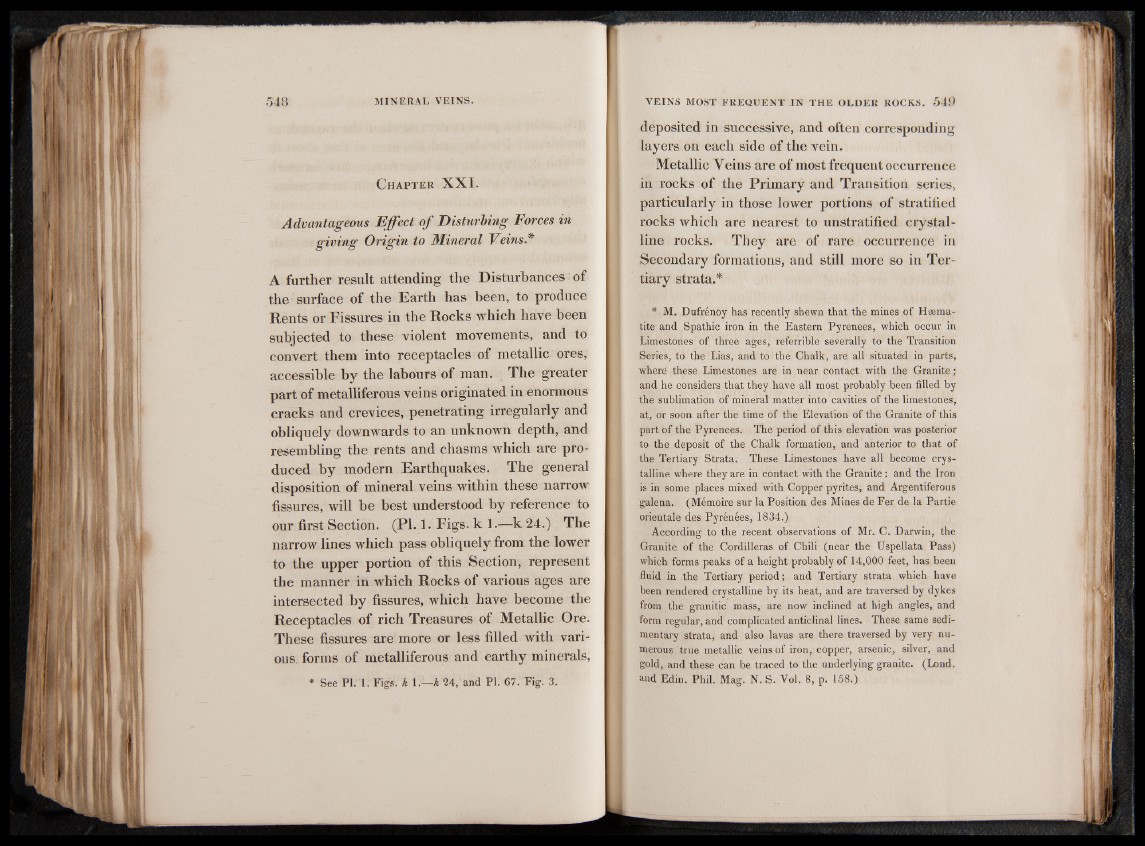
Chapter X X I .
Advantageous Effect of Disturbing Forces in
giving Origin to Mineral Veins*
A further result attending the Disturbances of
the surface of the Earth has been, to produce
Rents or Fissures in the Rocks which have been
subjected to these violent movements, and to
convert them into receptacles of metallic ores,
accessible by the labours of man. The greater
part of metalliferous veins originated in enormous
cracks and crevices, penetrating irregularly and
obliquely downwards to an unknown depth, and
resembling the rents and chasms which are produced
by modern Earthquakes. The general
disposition of mineral veins within these narrow
fissures, will be best understood by reference to
our first Section. (PI. 1. Figs, k 1.— k 24.) The
narrow lines which pass obliquely from the lower
to the upper portion of this Section, represent
the manner in which Rocks of various ages are
intersected by fissures, which have become the
Receptacles of rich Treasures of Metallic Ore.
These fissures are more or less filled with various.
forms of metalliferous and earthy minerals,
* See PI. 1; Figs, k \ .—k 24, and PI. 67. Fig. 3.
deposited in successive, and often corresponding
layers on each side o f the vein.
Metallic Veins are o f most frequent occurrence
in rocks o f the Primary and Transition series,
particularly in those lower portions o f stratified
rocks which are nearest to unstratified crystalline
rocks. They are of rare occurrence in
Secondary formations, and still more so in Tertiary
strata.*
* M. Dufrenoy has recently shewn that the mines of Haematite
and Spathic iron in the Eastern Pyrenees, which occur in
Limestones of three ages, referrible severally to the Transition
Series, to the Lias, and to the Chalk, are all situated in parts,
where these Limestones are in near contact with the Granite;
and he considers that they have all most probably been filled by
the sublimation of mineral matter into cavities of the limestones,
at, or soon after the time of the Elevation of the Granite of this
part of the Pyrenees. The period of this elevation was posterior
to the deposit of the Chalk formation, and anterior to that of
the Tertiary Strata. These Limestones have all become crystalline
where they are in contact with the Granite; and the Iron
is in some places mixed with Copper pyrites, and Argentiferous
galena. (Memoire sur la Position des Mines de Fer de la Partie
orientale des Pyrenees, 1834.)
According to the recent observations of Mr. C. Darwin, the
Granite of the Cordilleras of Chili (near the Uspellata Pass)
which forms peaks of a height probably of 14,000 feet, has been
fluid in the Tertiary period; and Tertiary strata which have
been rendered crystalline by its heat, and are traversed by dykes
from the granitic mass, are now inclined at high angles, and
form regular, and complicated anticlinal lines. These same sedimentary
strata, and also lavas are there traversed by very numerous
true metallic veins of iron, copper, arsenic, silver, and
gold, and these can be traced to the underlying granite. (Lond.
and Edin. Phil. Mag. N. S. Vol. 8, p. 158.)